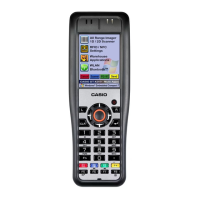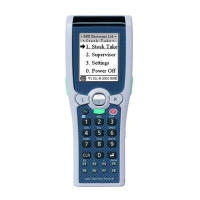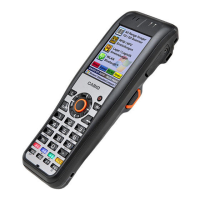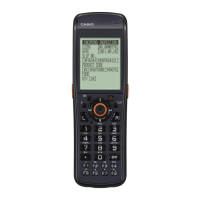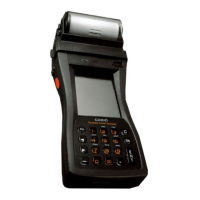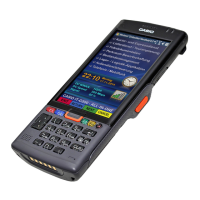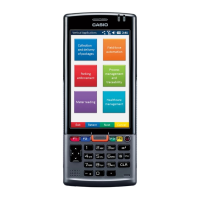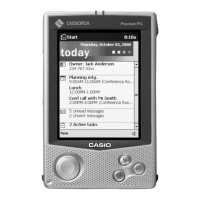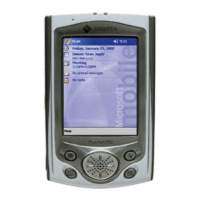Do you have a question about the Casio DT-X100 Series and is the answer not in the manual?
Explains warning symbols, disassembly, and abnormal conditions.
Covers dust, moisture, laser, interference, foreign objects, location, LCD, and temperature risks.
Details critical safety warnings for battery use, charging, disposal, and potential hazards.
Safety guidelines for using the AC adaptor and power cord.
Emphasizes the necessity of backing up important data regularly.
Covers battery, temperature, dust, chemicals, terminals, and IP rating precautions.
Includes Wi-Fi restrictions and an explanation of dead pixels on the LCD.
Provides tips to extend the lifespan and proper maintenance of the battery pack.
Notes on programming procedures and contacting for service.
Details European regulatory information and lists available terminal options.
Illustrates and labels the physical components of the DT-X100 terminal.
Explains the meaning of indicator lights and the basic functions of key buttons.
Describes the operation of various keys like numeric, cursor, Fn, and function keys.
Details the barcode reader port, IR port, power contacts, and data communication terminal.
Explains how to use strap holes, hand belt holes, and mount holes.
Describes the function of the battery pack cover lock switch.
Explains the main battery pack and the built-in backup battery.
Introduces the steps for loading the battery pack into the terminal.
Provides detailed instructions and illustrations for installing the battery pack.
Details the procedure for safely removing the battery pack from the terminal.
Crucial warnings and precautions to follow during battery removal.
Instructions on how to attach the hand strap to the handheld terminal.
Explains how to enable and operate the mouse emulator function.
Details how to move the cursor and perform left clicks using the keypad.
Describes how to perform right clicks, double clicks, and drag operations.
Provides steps to manually adjust the display brightness for better readability.
Explains how to set the automatic display dimming feature.
Instructions on how to use the laser scanner to read barcodes.
Provides important advice for successful and efficient barcode scanning.
Explains the meaning and importance of laser warning labels.
Guidance on correctly positioning the scanner relative to barcodes.
Step-by-step instructions to adjust the laser light emission width.
Details the calibration process using specific bar codes and the trigger key.
Instructions for reading barcodes and 2D codes using the C-MOS imager.
Essential tips for optimal performance and troubleshooting imager scanning.
Explanation of the laser warning label specific to the C-MOS imager module.
Direct warning to avoid looking into the laser light when using the C-MOS imager.
Instructions for establishing Bluetooth connections and understanding communication range.
Advice on avoiding interference and ensuring successful wireless communication.
Instructions on how to perform a reset to restore normal operation.
Details the process for a full reset, including warnings about data deletion.
Specifications for CPU, Memory, OS, and Display.
Technical details for Laser Scanner, C-MOS Imager, Bluetooth, and WLAN.
Information on wireless frequencies, data transfer rates, and communication range.
Details on power source, consumption, and estimated battery life.
Specifies operating temperature, humidity, and dust/water resistance.
Provides the physical dimensions, weight, and vibrator function details.
Illustrated diagram showing the physical dimensions of the handheld terminal.
Introduces the USB cradle and its functions for data transfer and charging.
Details the USB ports, power switch, LED indicators, and power contacts.
Explains how to properly mount the DT-X100 into the USB cradle using mount hooks.
Step-by-step instructions for connecting the AC adaptor and powering the USB cradle.
Guides on connecting the cradle to a PC via USB or to other USB peripherals.
Instructions for correctly seating the DT-X100 in the cradle for charging.
Explains the status indications of Indicator 1 on the DT-X100 when in the cradle.
Important safety advice and precautions for using the USB cradle.
Details USB protocol, charging methods, power supply, and AC adaptor specifications.
Provides specifications for dimensions, weight, and operating environment.
Introduces the Ethernet cradle and its capabilities for data transfer and charging.
Details USB/LAN ports, power switch, selector, LEDs, and power contacts.
Explains how to properly mount the DT-X100 into the Ethernet cradle.
Step-by-step instructions for connecting the AC adaptor and powering the Ethernet cradle.
Guides on connecting the cradle to a LAN or PC using the appropriate cables.
Instructions for correctly seating the DT-X100 in the cradle for charging.
Explains the status indications of Indicator 1 on the DT-X100 when in the cradle.
Important safety advice and precautions for using the Ethernet cradle.
Details LAN, USB, charging, power supply, and AC adaptor specifications.
Provides specifications for dimensions, weight, and operating environment.
Introduces the cradle-type battery charger and its function.
Step-by-step instructions for connecting the AC adaptor to the cradle-type charger.
Explains the status indications of Indicator 1 on the DT-X100 when in the charger.
Important safety advice and precautions for using the cradle-type battery charger.
Details charging, power supply, AC adaptor, and environment specifications.
Introduces the cradle-type dual battery charger for simultaneous charging.
Details the connection brackets and screws used for linking multiple chargers.
Instructions for charging battery packs and interpreting the charging status indicator.
Step-by-step guide to connect multiple dual battery chargers together.
Details charging, power supply, AC adaptor, and environment specifications.
Important safety advice and precautions for using the dual battery charger.
Introduces the dual battery charger for simultaneous charging of two battery packs.
Explains charger LEDs, adaptor jack, connection port, and power contacts.
Important safety advice and precautions for using the dual battery charger.
Instructions for charging battery packs and interpreting the charging status indicator.
Step-by-step guide to connect multiple dual battery chargers together.
Details charging, power supply, AC adaptor, and environment specifications.
Information on selecting and using different battery pack types.
Important advice for storing and transporting lithium-ion battery packs.
Technical specifications for the standard and large-capacity battery packs.
Lists the components of the hand belt kit and provides attachment instructions.
Important notes regarding secure insertion of the terminal with a hand belt into cradles.
